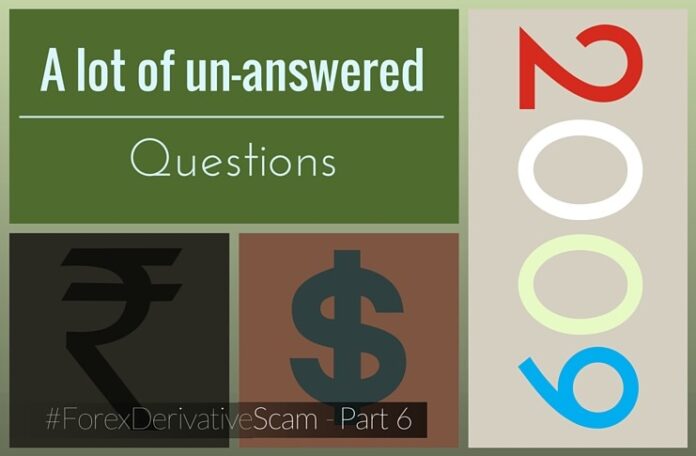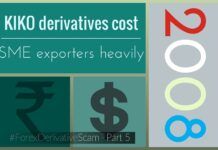
Let us recap what happened so far… SME (Small and Medium Enterprise) exporters were sold exotic derivatives as a panacea for their currency exchange woes. Initial success spurred them to start using exotic derivatives to speculate rather than hedge the currency they were concerned with. When the rupee reversed course and started depreciating again, the losses compounded owing to the asymmetric nature of Knock In Knock Out (KIKO) derivatives.
Some questions that jump out:
-
Did the SME exporters buy these derivatives knowing fully what they were getting into?
-
The Reserve Bank of India (RBI) has mandated FEMA (Foreign Exchange Management Act) regulations on derivatives that are well intended. Did the RBI enforce the regulations on the Banks?
-
RBI regulations mandate that derivative and hedging products be sold only by the existing banker to the SMEs. But several Banks approached SMEs to solely sell these derivative products. Should this not have been caught at an early stage?
-
These contracts were marketed by banks for a short period in 2007-08 coinciding with the appreciation of the Rupee. These “exotic” derivative contracts were never marketed before this period nor were they after. These were marketed only to Exporters, never to importers, who too had Forex risks. Was there a coordinated effort by Banks to target a specific set of customers?
Some pointed questions from the petition:
We reproduce from the petition (see Pages 35-37 in the attachment) below some pointed (and uncomfortable questions) for the banks in general and the RBI in particular:
-
How much profit or loss did the bankers make in India from such illegal contracts?
-
How much was the concomitant loss or gain for the exporters in India?
-
How much was recovered by the banks from the exporters?
-
How much was settled by the banks for lesser amounts?
-
How much waived by the banks in India?
-
If the contracts were indeed legal what was the compelling need for the bankers to settle the same for a lower amount that too with such great haste?
-
How much of the contract value are under litigation in various courts in the country as on date?
-
How much of these profits transmitted to financial institutions out of India?
-
Was all this part of a larger conspiracy involving foreign institutions and international players?
-
Why is it that all these coincided with the global financial crisis of 2008?
-
Was all this part of a larger global game plan with some institutions within India part of the charade?
-
How come the RBI despite acknowledging the fact that these contracts were violative of FEMA as early as in 2009 not refer the matter to Enforcement Directorate till date?
-
Why did RBI take action on the Banks under the Banking Regulation Act and not under FEMA?
-
Why did RBI despite overwhelming evidence of a massive FEMA violation allow banks with a mild penalty under the Banking regulation Act?
-
Was this an elaborate Money Laundering exercise carried out in full public glare with the tacit consent of all Regulators in India?
-
If the banks sold such illegal derivatives and despite acknowledging the same why RBI has remained silent?
-
Why did the banks sell such “exotic” derivatives in tandem only to exporters [and not to importers] in 2008-09 coinciding with the steep appreciation of the Rupee?
-
Why is it that banks stopped marketing such products since then either to exporters or to other players in the Forex markets?
-
The fact that all these nineteen banks marketed similar structured products, each contract being identically worded and designed as the other and with the banks emerging as the ultimate beneficiary of such contracts being violative of FEMA, points out to a prima facie evidence of a conspiracy. Despite such an overwhelming evidence, why is it that no investigating agency ever taken up this angle?
-
Was there a foreign counterparty to the Indian Banks who entered into wholesale contracts and retailed the same to hapless innocent Indian exporters who were predominantly small and medium enterprises? If so, was the profits from such contracts too shifted abroad as a ruse to honor these contracts?
Conclusion
M R Venkatesh, a noted writer, commentator, auditor and TV personality, has filed a petition with the Special Investigation Team (SIT) on Black Money, constituted by the Supreme Court of India to immediately intervene and review this Forex Derivative Scam. The petition alleges that in several instances, the Regulator, notably the RBI either failed to or did not intervene.
The petition goes on to say matters were brought to the attention of the RBI as early as 2007-08 by individual exporters. Yet, RBI for reasons best known to it did not interfere and maintained a studied silence. Then as the disparate outcry of individuals turned into a desperate chorus of exporters across the country the media took notice. The crux of the contracts seems to be that the Banks were saying, “Heads we win, Tails you lose!”
The petition has been submitted to the SIT on April 7, 2016. Till date, no action has been taken by the SIT team. Will this be taken up in the upcoming Parliament session? Is this more important than say passing the GST Bill? Should SMEs continue to suffer with the double whammy of high interest rates and exposures to exotic derivatives? Only time will tell.
Below is a copy of the petition to the SIT team:
- Supreme Court rejects plea to tally all VVPAT slips with EVM votes; says ‘no going back to paper ballot’ - April 26, 2024
- US report citing human rights violations is deeply biased: India - April 25, 2024
- Kotak Mahindra Bank shares tank 13%. Market Cap erodes by Rs.37,721 cr post-RBI action - April 25, 2024










